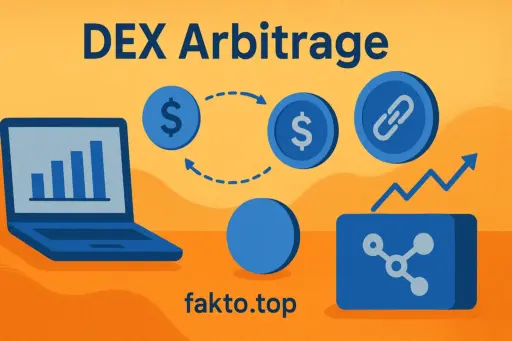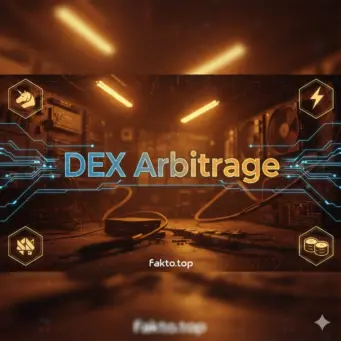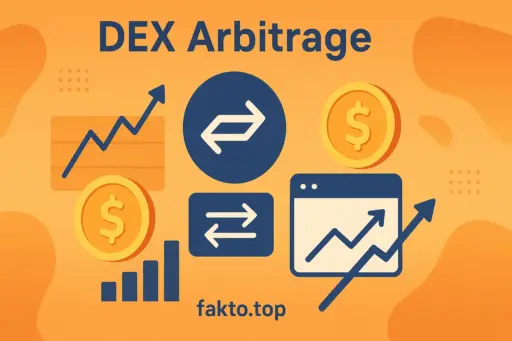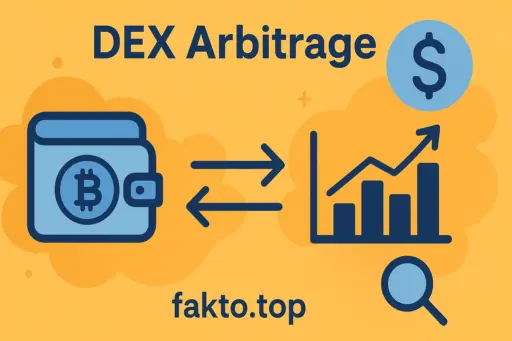Mastering DEX Arbitrage: Flash Loans, MEV, and Bot Guide
Mastering the DEX Arbitrage Strategy: A Handbook for Advanced On-Chain Trading
DEX arbitrage strategy is the art of exploiting fleeting price inefficiencies across liquidity pools on decentralized exchanges.
These imbalances arise because automated market makers (AMMs) rely on constant product formulas and do not react instantly to price shifts on centralized exchanges (CEX).
Traders, historically relying on manual detection, now face sub-second windows where profits exist, making high-speed automation essential.

The objective is simple in theory: buy low, sell high, and capture the spread. In practice, the competition is fierce, with bots monitoring thousands of token pairs. Success demands technical know-how, precise timing, and capital-efficient methods like flash loans to leverage arbitrage without upfront capital risk.
The Foundational Mechanics: Why Arbitrage Exists on DEXs
Decentralized exchanges differ fundamentally from CEXs, which operate on order books with continuous bid-ask spreads. AMMs, instead, use liquidity pools where token reserves determine pricing through an AMM pricing mechanism.
When trades push prices away from the equilibrium observed on other platforms, temporary imbalances occur, creating arbitrage windows. Arbitrageurs act to restore parity, ensuring liquidity pools reflect global market prices. This is a self-correcting mechanism: without arbitrage, liquidity pools would deviate persistently, mispricing assets.
Understanding this dynamic is crucial, as all DEX arbitrage strategies depend on exploiting these brief disparities while considering fees, slippage, and transaction speed to maintain profitability.
Understanding the AMM Invariant Formula (x*y=k)
The core of AMM mechanics is the constant product formula, expressed as x*y=k, where x and y are token reserves and k is constant. Large trades shift reserves dramatically, causing prices to deviate from external references.
Uniswap V3’s concentrated liquidity adds complexity but preserves the same principle: price impact is proportional to trade size relative to liquidity depth. Arbitrageurs monitor these reserve imbalances, spotting opportunities where one pool’s price lags another.

Liquidity pools with insufficient depth are highly volatile, creating larger but riskier windows. Success depends on calculating expected returns net of slippage, fees, and gas costs while executing transactions atomically to ensure the trade either completes fully or not at all, protecting capital.
Slippage vs. Arbitrage Opportunity
Slippage represents the expected loss from executing a trade that moves the price within a liquidity pool, while an arbitrage opportunity exists when price disparities allow a net positive return. The key insight is that slippage itself generates arbitrage potential: a large trade distorts the pool price, creating a gap compared to other exchanges.
Arbitrageurs close this gap almost instantly, profiting while aligning prices across platforms. Transaction atomicity ensures the entire sequence of trades executes as a single unit, so failed transactions revert, avoiding partial exposure.
Mastery involves distinguishing between normal slippage and actionable arbitrage, calculating risk-adjusted returns, and determining the optimal trade size to maximize profit without triggering excessive price impact.
The Essential Tool: Crypto Flash Loan Arbitrage
Flash loans revolutionized DEX arbitrage by offering uncollateralized capital for a single atomic transaction. The most powerful tool available to exploit price gaps in DeFi is undoubtedly Flash Loan Arbitrage, removing upfront capital risk entirely. Borrowing, executing sequential swaps across pools, and repaying within one transaction allows traders to capture spreads that would otherwise require significant liquidity.
Timing, precise coding, and gas optimization are crucial, as failure to repay instantly cancels the transaction. Flash loans amplify profitability while minimizing capital exposure, but they also attract fierce competition. Understanding the mechanics, fees, and atomic execution is the gateway to scaling arbitrage operations successfully in today’s high-speed DeFi environment.
Flash Loan Arbitrage Explained Step by Step
Flash loan arbitrage follows a precise five-step process: first, the bot checks for profitable price discrepancies; second, it borrows assets via a flash loan; third, it executes the first trade on a target DEX; fourth, it completes the second trade to capture the spread; finally, the loan is repaid within the same atomic transaction.
The atomicity ensures that if any step fails, the entire transaction reverts, avoiding losses. Developers must encode these steps in smart contracts with high reliability, integrating real-time data feeds and gas optimization logic.

This methodology allows traders to exploit opportunities at scale without risking their own capital, relying solely on precise timing and execution.
Identifying Profitable Triangular Arbitrage DEX Loops
Triangular arbitrage DEX loops involve cycling through three tokens on a single exchange to exploit pricing inefficiencies. For example, A → B → C → A. If the compounded trade returns more of token A than initially invested, the loop is profitable. Spotting these requires specialized pathfinding algorithms that evaluate thousands of token combinations in real time.
Efficiency is critical: the smallest latency can turn a profitable path into a loss. Arbitrage bots often prioritize high-liquidity pools to reduce slippage and maximize net gains.
Understanding the structure of pools, reserve ratios, and AMM behavior allows traders to pinpoint which loops offer genuine opportunity rather than chasing noise in low-volume pairs.

Automation is Mandatory: Building and Deploying a DEX Arbitrage Bot
Manual trading is dead in DEX arbitrage. Opportunities exist for milliseconds, making automation mandatory. A DEX arbitrage bot has two main parts: an off-chain monitoring engine and an on-chain execution contract. The monitoring engine continuously scans pools, calculates spreads, and identifies profitable paths.
The smart contract executes trades atomically, ensuring that borrow, swaps, and repayment happen in one go. Speed, reliability, and gas optimization are the differentiators between winners and losers. Bots must handle sudden pool imbalances, prioritize high-fee routes when necessary, and integrate flash loan logic.
Without automation, human reaction time simply cannot compete with competing bots and MEV searchers in real-time markets.
Selecting the Best Open Source DEX Arbitrage Bot (Templates and Customization)
Open-source DEX arbitrage bots provide a solid foundation but need customization to remain competitive. Evaluating Solidity and Node.js components for reliability and security is the first step.
Adjustments usually include gas optimization, custom routing logic, and priority fee settings. Smart contract integration must ensure atomic execution and flash loan compatibility. Modifying templates helps differentiate your bot from the dozens of others using the same base code.
Community-supported projects often have good documentation, but real-world performance depends on understanding AMM mechanics, liquidity depth, and slippage patterns. Regular updates and backtesting are critical to maintain a profitable edge in ever-changing markets.

Choosing Real-Time Data Sources (WebSockets vs. The Graph)
Data latency can make or break DEX arbitrage. Standard RPC endpoints are reliable but slow; WebSockets provide near-instant updates on pending blocks, while The Graph offers indexed historical data.
Combining both can be optimal: WebSockets detect immediate opportunities, The Graph allows backtesting and analyzing liquidity patterns. Superior data sources give the bot an edge in spotting price gaps before competitors react. Ignoring latency differences can erase profits.
Real-time block data allows bots to pre-calculate transaction sequences, estimate slippage, and optimize gas in advance. Proper integration of live and historical data feeds is a subtle but decisive factor in profitable arbitrage operations.
The Execution Layer: Winning the Gas War and Ensuring Atomicity
Execution is where DEX arbitrage separates experts from amateurs. Arbitrage logic is simple; execution is brutal. Each block is a race: the fastest, most gas-efficient transaction captures the spread. Suboptimal gas settings or delayed submissions result in missed opportunities or outright losses. Atomic transactions are crucial—everything must succeed or revert.
The winner takes all because multiple bots chase the same gap. Gas wars escalate as traders increase priority fees, creating a delicate balance between speed and cost.
Mastering execution requires understanding block production, gas dynamics, and validator behavior, ensuring the bot consistently wins when opportunities appear.
DEX Arbitrage Gas Fee Optimization with EIP-1559
Optimizing gas under EIP-1559 is essential for profitable DEX arbitrage. Each transaction pays a base fee plus a priority fee, which incentivizes validators to include it quickly. Setting the right priority fee is a balancing act: too low and the transaction stalls; too high and profits erode.
Bots can dynamically adjust fees based on network congestion, estimated block times, and competition intensity. Integrating this into smart contract logic ensures that arbitrage trades execute at optimal speed without overspending.
Effective EIP-1559 gas strategy minimizes wasted capital and maximizes net gains, giving the bot a competitive edge in a crowded arbitrage ecosystem.
Trade Batching and Transaction Atomicity
In DEX arbitrage, batching multiple operations into one atomic transaction is non-negotiable. Borrowing, swapping, and repaying must execute as a single unit. If any step fails, the transaction reverts, protecting capital from partial execution losses.
Atomicity ensures flash loans can be used safely, and arbitrage profits are secured. Smart contracts encode these sequences with precision, handling edge cases like insufficient liquidity or slippage. Without atomic execution, bots risk losing both potential profits and borrowed funds.
Mastering this technique is fundamental to advanced strategies, letting traders operate confidently in high-speed environments while minimizing execution risk across volatile AMM pools.
Risk Mitigation and the MEV Arbitrage Strategy Landscape
Maximal Extractable Value (MEV) defines the harsh reality of on-chain trading. Beyond competing with other bots, traders now contend with specialized MEV searchers and block builders who can reorder or front-run transactions. MEV arbitrage strategy involves identifying profitable opportunities while protecting against these adversaries.
Some traders collaborate with searchers, submitting private bundles directly to validators, bypassing public mempools. Understanding MEV dynamics is crucial for profitability and safety, as ignoring it can turn seemingly lucrative trades into losses.
Arbitrageurs must continuously monitor block-level activity, adjust gas tactics, and refine contract logic to operate effectively in an increasingly competitive landscape.
Protecting Against and Identifying Frontrunning Attacks
Frontrunning is when another bot detects a profitable pending transaction and submits its own with higher gas to execute first. This can nullify expected profits or even create losses. Defense strategies include private transaction relays, sending bundles directly to MEV searchers, or using flashbots to bypass the public mempool.
Identifying potential frontrunning requires monitoring pending transactions, predicting competitor behavior, and dynamically adjusting execution parameters. Awareness of network congestion and gas dynamics is critical.
Successful arbitrage is as much about speed as it is about strategy: defending against frontrunners ensures that profits aren’t stolen before trades complete.
Advanced MEV Arbitrage Strategy and Bundle Submission
Advanced MEV arbitrage strategy relies on structuring transaction bundles for direct submission to block builders. Traders can include multiple arbitrage paths in one bundle, guaranteeing execution order and reducing exposure to mempool competition.
Becoming an MEV searcher involves creating sophisticated software to detect opportunities, simulate profitability, and submit bundles efficiently. These tactics allow traders to operate in high-speed, high-competition environments while securing profits that would otherwise be claimed by external searchers. Understanding block timing, gas optimization, and bundle structuring is critical.
Mastering this layer of MEV tactics transforms a simple arbitrage bot into a powerful tool capable of consistently capturing fleeting on-chain opportunities.
Practical Backtesting and Sandbox Testing
Backtesting is essential before committing real capital. Using historical blockchain data, traders simulate arbitrage scenarios to identify profitable loops, estimate slippage, and test gas strategies. Sandbox testing on testnets like Sepolia allows running full smart contracts without risking funds, exposing bugs or logic flaws that could cause losses. Proper backtesting accounts for AMM pricing mechanics, liquidity depth, and network latency, providing realistic expectations. Combining historical analysis with live testing ensures that the bot behaves as intended under real conditions. This practice is mandatory for professional arbitrageurs and forms the foundation of risk management, ensuring strategies are both profitable and resilient to execution errors.
Expanding Horizons: Cross-Chain and Multi-Chain DEX Arbitrage
Limiting arbitrage to a single chain leaves money on the table. Cross-chain and multi-chain DEX arbitrage leverages fragmented liquidity across Ethereum, Solana, Avalanche, and L2 scaling solutions. Traders can exploit price inefficiencies that exist because assets take time to move between chains. While opportunities exist, risks include non-atomic execution, high bridge fees, and network latency. Multi-chain arbitrage demands deep understanding of block production times, bridge mechanics, and gas optimization across different protocols. Scaling into L2 environments like Arbitrum or Polygon offers cheaper gas, allowing profitable trades on smaller spreads. Successful expansion requires robust monitoring, fast execution, and careful capital allocation across chains to maximize returns.
Cross-Chain DEX Arbitrage Challenges and Bridges
Cross-chain DEX arbitrage introduces unique challenges. Unlike single-chain trades, transactions are no longer atomic, as they rely on separate block production processes. Moving assets across chains typically requires bridges, which can be slow, costly, or vulnerable to failure. Traders must factor in latency, fees, and potential slippage while ensuring trades remain profitable after bridge costs. Effective strategies often involve pre-positioning capital on target chains or using fast liquidity protocols to minimize delay. Understanding each network’s finality and bridge mechanics is crucial. Without careful planning, a promising arbitrage opportunity can quickly turn into a loss, highlighting the importance of risk management in multi-chain environments.
Arbitrage on L2 Scaling Solutions (Polygon, Arbitrum)
Layer 2 solutions like Polygon and Arbitrum offer drastically lower gas fees, opening arbitrage possibilities on smaller spreads that would be unprofitable on Ethereum mainnet. Bots can execute trades more frequently, capturing micro inefficiencies across pools. However, competition remains fierce, requiring precise execution and smart gas management. L2 chains still face congestion and occasional finality delays, so bots must adapt dynamically. Integrating monitoring, flash loans, and atomic swaps across multiple L2s demands sophisticated code and real-time data handling. Despite these challenges, Layer 2 arbitrage can be highly profitable, especially when combined with automated strategies that quickly identify and exploit fleeting price differences on fast-moving decentralized exchanges.
The Bottom Line: How to Make Money with DEX Arbitrage Consistently
Consistent profits in DEX arbitrage require more than catching a single trade. How to make money with DEX arbitrage involves minimizing gas costs, optimizing bot latency, and constantly refining smart contract logic. Traders must account for flash loan fees, swap costs, and network conditions while monitoring multiple pools across chains. Automation, backtesting, and MEV-aware strategies are essential to maintain an edge. The goal is to identify recurring inefficiencies, execute atomically, and scale trades without introducing excessive risk. With discipline, technical knowledge, and careful capital allocation, arbitrageurs can transform fleeting price gaps into a steady revenue stream while staying competitive in increasingly sophisticated on-chain markets.
Calculating DEX Arbitrage Profit Margins (Detailed Breakdown)
Profit calculation is critical for evaluating DEX arbitrage opportunities. Net profit equals gross gains minus fees: flash loan fees (typically 0.09%), DEX swap fees (around 0.3%), and gas (base + priority fee under EIP-1559). Traders must factor in slippage, pool liquidity, and bridge costs for multi-chain operations. Small miscalculations can turn a profitable trade into a loss. Advanced bots incorporate dynamic profit calculators, adjusting for real-time conditions to ensure trades remain net positive. Understanding each component allows precise trade sizing and risk management. Calculating profit accurately is fundamental to sustaining operations, as repeated small losses from misestimated fees or slippage erode capital over time.
Case Study: A Successful CEX/DEX Arbitrage Scenario
Consider a scenario where ETH is priced lower on a DEX than on a CEX. A trader uses a flash loan to acquire ETH on the DEX and simultaneously sells it on the CEX. Execution speed and capital management are crucial: the borrowed amount must cover both the DEX purchase and transaction fees, with the spread exceeding all costs. By batching operations atomically and monitoring gas prices, the trader captures the arbitrage profit before market correction. This hybrid approach illustrates practical application of DEX and CEX monitoring, flash loans, and automated execution. Careful planning, precise timing, and risk calculation make such strategies repeatable, not just lucky one-offs.
Illustrative Scenario: Applying CEX/DEX Arbitrage with Numbers
In this hypothetical case, a trader spots ETH priced at $1,995 on a DEX while the same ETH trades at $2,010 on a CEX. Using a flash loan, the bot buys ETH on the DEX and immediately sells it on the CEX. Atomic execution ensures the loan is repaid in the same transaction if any step fails. Fees for swaps, gas, and the flash loan are deducted, leaving a net profit. This scenario highlights precise capital management, real-time data monitoring, and automated execution. Even small spreads become profitable with speed and accuracy. The case demonstrates how coordinated DEX/CEX strategies turn small inefficiencies into consistent gains.
Future Trends and Staying Ahead of the Arbitrage Game (Conclusion)
The DEX arbitrage landscape evolves rapidly. Simple price gaps are becoming rare due to increased bot competition and MEV-aware validators. Future trends include more sophisticated MEV infrastructure, multi-chain opportunities, and the rise of Layer 2 solutions. Arbitrageurs must adapt by continuously refining bot logic, integrating advanced data feeds, and optimizing gas strategies. Staying ahead means thinking beyond isolated trades: automated monitoring, real-time analytics, and cross-chain liquidity management will define profitability. Continuous learning, sandbox testing, and innovation are critical. Those who embrace these trends early will capture opportunities that are invisible to slower, less adaptable participants, maintaining an edge in increasingly competitive markets.
Final Recommendations for Aspiring Arbitrageurs (Summary)
Three core takeaways define successful DEX arbitrage: start on testnets to perfect strategies without risking real capital; focus relentlessly on gas efficiency and execution speed; and treat the bot as a constantly evolving system. Arbitrage is not static; markets change, competition intensifies, and new tools emerge. Continuous testing, backtesting, and iterative improvement are mandatory. Understanding AMM mechanics, flash loan execution, and cross-chain risks ensures strategies are grounded in reality. Approach trading as a combination of engineering, analytics, and timing. With diligence, a methodical approach, and careful risk management, aspiring arbitrageurs can turn fleeting price gaps into reliable, repeatable profits while staying resilient in high-speed DeFi ecosystems.
Disclaimer
The strategies described in this handbook are intended for educational purposes only. DEX arbitrage, flash loans, and MEV operations involve significant financial risk, including the potential loss of capital. Market conditions, network congestion, and smart contract vulnerabilities can all affect outcomes. Readers should not attempt trades without sufficient technical knowledge, testing on testnets, and a clear understanding of gas fees, slippage, and atomic execution. Always conduct thorough research, backtesting, and risk management before deploying real funds. This content does not constitute financial advice, and the authors are not responsible for any losses resulting from the implementation of the techniques discussed.
